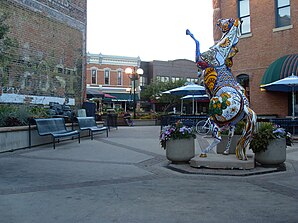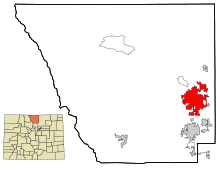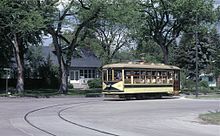Fort Collins
| Fort Collins | |
|---|---|
 Historic District in downtown Fort Collins |
|
 flag |
|
| Location in Colorado | |
| Basic data | |
| Foundation : | 1864 |
| State : | United States |
| State : | Colorado |
| County : | Larimer County |
| Coordinates : | 40 ° 34 ′ N , 105 ° 5 ′ W |
| Time zone : | Mountain ( UTC − 7 / −6 ) |
|
Inhabitants : - Metropolitan Area : |
164,207 (as of 2016) 339,993 (as of 2016) |
| Population density : | 1,362.7 inhabitants per km 2 |
| Area : | 122.1 km 2 (approx. 47 mi 2 ) of which 120.5 km 2 (approx. 47 mi 2 ) is land |
| Height : | 1525 m |
| Postcodes : | 80521-80528, 80553 |
| Area code : | +1 970 |
| FIPS : | 08-27425 |
| GNIS ID : | 0204673 |
| Website : | fcgov.com |
| Mayor : | Calf Troxell |
Fort Collins is the largest city and seat of the administration ( county seat ) of Larimer County in the US state of Colorado with 143,986 inhabitants (as of 2010). The city lies on the Cache la Poudre River . Fort Collins was founded as a military fort in 1864, named after Colonel William O. Collins , the former commandant of Fort Laramie . The American WWV time signal transmitter has been located in the city since 1966 .
geography
Fort Collins's geographic coordinates are 40 ° 34 ′ N , 105 ° 5 ′ W (40.559238, −105.078302). The city is located directly east of the foothills of the Rocky Mountains on the Northern Front Range , about 100 km north of Denver, Colorado and about 70 km south of Cheyenne, Wyoming . Landmarks in the urban area include Horsetooth Reservoir and Horsetooth Mountain, which is named because a tooth-shaped granite boulder dominates the western skyline of Fort Collins.
According to the United States Census Bureau , the city has a total area of 122.1 km 2 , of which 120.5 km 2 is land and 1.6 km 2 (= 1.27%) is water. The urban area is drained by the Cache la Poudre River and Spring Creek . Fort Collins has about 296 days of sunshine per year.
Fort Collins is the largest city in the mostly rural Colorado 4th Congressional District . At the state level, the city is located in the 14th Senate constituency and is divided into the 52nd and 53rd constituencies for the Colorado House of Representatives . Fort Collins is also the county seat for Larimer County .
history
Founded in 1864 as a military outpost of the United States Army , Fort Collins followed an earlier military camp known as Camp Collins , located on the Cache la Poudre River, near what is now Laporte . Camp Collins was established during the Indian Wars of the 1860s to protect the postal route through the region. Travelers who crossed the country on the Overland Trail also camped here. The base was destroyed by a flood in June 1864. The camp commander then wrote to the commander of Fort Laramie in southeast Wyoming, Colonel William O. Collins, suggesting that a site a few miles downstream would be a good place to build a fort. The post was manned by two companies of the 11th Ohio Volunteer Cavalry , but never had walls or palisades.
Immediately after the fort was founded, settlers began to move into the area. The fort itself was decommissioned in 1867. The place where the fort was originally located is now adjacent to the old town. The first school and church opened in 1866 and the city was founded in 1867. The civilian population, led by businessman Joseph Mason, campaigned for the county seat to be moved from Laporte to Fort Collins, which they succeeded in 1868.
The first lectures at the new state agricultural college were held in 1870. The next population surge came in 1872 with the establishment of an agricultural colony. This led to the arrival of hundreds of settlers who settled south of the old town. Tensions between new settlers and those who had previously arrived led to political strife in the city, which became independent in 1873.
Numerous elegant residential and commercial buildings were built in the 1880s. The operation of quarries, the cultivation of sugar beets and the slaughter of sheep were among the first industrial businesses in the city. The beet cultivation, which was supported by the college and its affiliated agricultural research institute, proved to be excellent and abundant fodder for the local sheep breeding. In 1901, the Great Western Sugar Company sugar refinery was built in the neighboring town of Loveland .
Although the city was affected by the global economic crisis and the great drought of the 1930s, the city continued to grow slowly and steadily in the first half of the 20th century. In the decade after World War II , the number of inhabitants doubled and the city prospered. Old buildings were torn down to make way for new, modern structures. With this revitalization came other changes, such as the closure of the sugar factory in 1955 and the adoption of new statutes introducing a city council the year before. The number of students at Colorado State University doubled during the 1960s.
At the end of the 20th century, the university was the most important economic factor in the city. Fort Collins earned a reputation as a conservative city in the 20th century with the prohibition of alcoholic beverages, which was a constant subject of political discussion in the early decades of the century. The alcohol ban was in effect from the 1890s until 1969, when student activism helped to abolish it. During this phase, civil rights activism and anti-war demonstrations created tension in the city, with some buildings on the university campus also going up in flames.
At the end of the 20th century, Fort Collins developed rapidly southwards, where several new construction areas and several shopping centers were built. In the 1980s, managing this growth and renewing the old town became a political priority for the city administration.
Fort Collins has been twin town of Alcalá de Henares in Madrid, Spain since 1995 .
A fire around the upper reaches of the Poudre River in 2012 meant that the water from the river could no longer be used for the city's drinking water supply due to the ash entering. This eliminated half of the water. For two years, the city had to tap reserves in the surrounding reservoirs until the catchment area of the Poudre River again supplied edible water.
traffic
Allegiant Air has regular passenger flights to nearby Fort Collins / Loveland Airport . The Denver International Airport is located about 110 km away. Fort Collins is connected to Denver by Interstate 25 .
Interstate 25 runs in a north-south direction on the east side of the city area. The US Highway 287 is within the city, the College Avenue and is the busiest street in Fort Collins; he cuts the city in half.
The public transport system includes a bus system with twelve lines, which run from Monday to Saturday. The Fort Collins Municipal Railway was once a streetcar , the three lines of which began at the intersection of Mountain and College Avenue. The rails were torn out after the tram shut down due to insufficient profitability in 1951. An approximately 2,400 m long section on West Mountain Avenue and Roosevelt Avenue has since been reconstructed and has been open to the museum on weekends and holidays since 1985 during the summer months .
Fort Collins is bike friendly; there are more than 350 km of designated bike paths or lanes reserved for bicycles in town, as well as paved bike trails along Spring Creek and Cache la Poudre River. There is also a ten kilometer unpaved bike path along the Horsetooth Reservoir.
Facilities
Fort Collins is best known for its American football team from Colorado State University .
Furthermore, Advanced Energy Industries Inc., a company that specializes in the production of semiconductors , has its headquarters in Fort Collins.
One of the oldest known archaeological sites in North America is located in a nature reserve belonging to the city, about 40 km north of the city. The Lindenmeier Site is considered the best known evidence of the prehistoric Folsom culture . The finds have been dated to 10,800 Before Present (~ 8850 BC).
Demographics
| Population development | |||
|---|---|---|---|
| Census | Residents | ± in% | |
| 1880 | 1356 | - | |
| 1890 | 2011 | 48.3% | |
| 1900 | 3053 | 51.8% | |
| 1910 | 8210 | 168.9% | |
| 1920 | 8755 | 6.6% | |
| 1930 | 11,489 | 31.2% | |
| 1940 | 12,251 | 6.6% | |
| 1950 | 14,937 | 21.9% | |
| 1960 | 25,027 | 67.6% | |
| 1970 | 43,337 | 73.2% | |
| 1980 | 65.092 | 50.2% | |
| 1990 | 87,758 | 34.8% | |
| 2000 | 118,652 | 35.2% | |
| 2010 | 143,986 | 21.4% | |
At the time of the United States Census 2000 , Fort Collins had 118,652 people, but Loveland is part of the Metropolitan Statistical Area (MSA) ; the total population of the MSA amounts to 251,494.
The population density was 984.4 people per km 2 . There were 47,755 housing units at an average of 396.2 per km 2 . The Fort Collins population was 82.40% White , 3.01% Black or African American , 0.60% Native American , 2.48% Asian , 0.12% Pacific Islander , 3.61% said belonging to other races and 2.53% named two or more races. 10.79% of the population declared to be Hispanic or Latinos of any race.
The residents of Fort Collins distributed to 45,882 households out of which 29.0% were living in children under the age of 18. 44.9% of households were married, 7.9% had a female head of the household without a husband and 43.8% were not families. 26.0% of households were made up of individuals and someone lived in 5.9% of all households aged 65 years or older. The average household size was 2.45 and the average family size was 3.01.
The population was divided into 21.5% minors, 22.1% 18–24 year olds, 31.5% 25–44 year olds, 17.0% 45–64 year olds and 7.9% aged 65 and over or more. The median age was 28 years. For every 100 women there were 100.9 men. For every 100 women over the age of 18, there were 99.7 men.
The median household income in Fort Collins was 44,459 US dollars and the median family income reached the amount of 59,332 US dollars. The median income for men was $ 40,856 compared to $ 28,385 for women. The per capita income was $ 22,133. 14.0% of the population and 5.5% of families had an income below the poverty line , including 8.3% of minors and 5.8% of those aged 65 and over.
sons and daughters of the town
- John Davidson Clark (1884–1961), economist and politician
- Dorothy Virginia Nightingale (1902-2000), chemist
- Bert Christman (1915–1942), comic artist and fighter pilot
- Byron Raymond White (1917–2002), Supreme Court Justice
- Richard Westfall (1924–1996), science historian
- Darwood Kaye (1929-2002), child actor
- Marie-Louise Göllner (* 1932), musicologist
- Bruce McEwen (1938-2020), neurophysiologist and endocrinologist
- Wayne Allard (born 1943), politician
- Randall H. McGuire (born 1951), archaeologist and anthropologist
- Andy Mill (* 1953), ski racer
- Lisa Jeffrey (* 1965), mathematician
- Jon Heder (born 1977), actor
- Ben Woolf (1980-2015), actor
- Masood Kamandy (* 1981), photographer and video artist
- Pretty Lights (born 1981), musician
- Derek Theler (* 1986), actor and model
- Scott Anderson (* 1989), racing car driver
- Jake Lloyd (born 1989), actor
Web links
supporting documents
- ↑ Flooding timeline in Fort Collins ( English ) Archived from the original on March 10, 2005. Accessed October 23, 2011th
- ^ A b Fort Collins Time Line 1860 ( English ) In: Fort Collins Local History Archive . Archived from the original on January 13, 2013. Info: The archive link was inserted automatically and has not yet been checked. Please check the original and archive link according to the instructions and then remove this notice. Retrieved October 23, 2011.
- ↑ History of Colorado State University ( English ) Retrieved on May 12 of 2007.
- ↑ Fort Collins Time Line 1890 ( English ) In: Fort Collins Local History Archive . Accessed on March 24, 2007. ( Page no longer available , search in web archives ) Info: The link was automatically marked as defective. Please check the link according to the instructions and then remove this notice.
- ↑ Fort Collins Time Line 1900 ( English ) In: Fort Collins Local History Archive . Archived from the original on January 13, 2013. Info: The archive link was inserted automatically and has not yet been checked. Please check the original and archive link according to the instructions and then remove this notice. Retrieved March 24, 2007.
- ↑ Fort Collins Time Line 1930 ( English ) In: Fort Collins Local History Archive . Archived from the original on January 13, 2013. Info: The archive link was inserted automatically and has not yet been checked. Please check the original and archive link according to the instructions and then remove this notice. Retrieved March 24, 2007.
- ↑ Fort Collins Time Line 1940 ( English ) In: Fort Collins Local History Archive . Archived from the original on January 12, 2013. Info: The archive link was inserted automatically and has not yet been checked. Please check the original and archive link according to the instructions and then remove this notice. Retrieved March 24, 2007.
- ↑ Fort Collins Time Line 1950 ( English ) In: Fort Collins Local History Archive . Archived from the original on January 13, 2013. Info: The archive link was inserted automatically and has not yet been checked. Please check the original and archive link according to the instructions and then remove this notice. Retrieved March 24, 2007.
- ^ A b Fort Collins Time Line 1960 ( English ) In: Fort Collins Local History Archive . Archived from the original on January 13, 2013. Info: The archive link was inserted automatically and has not yet been checked. Please check the original and archive link according to the instructions and then remove this notice. Retrieved March 24, 2007.
- ↑ Fort Collins Time Line 1880 ( English ) In: Fort Collins Local History Archive . Archived from the original on February 10, 2013. Info: The archive link was inserted automatically and has not yet been checked. Please check the original and archive link according to the instructions and then remove this notice. Retrieved March 24, 2007.
- ↑ a b Fort Collins Time Line 1970 ( English ) In: Fort Collins Local History Archive . Archived from the original on November 5, 2010. Info: The archive link was automatically inserted and has not yet been checked. Please check the original and archive link according to the instructions and then remove this notice. Retrieved March 24, 2007.
- ↑ Fort Collins Time Line 1980 ( English ) In: Fort Collins Local History Archive . Archived from the original on January 13, 2013. Info: The archive link was inserted automatically and has not yet been checked. Please check the original and archive link according to the instructions and then remove this notice. Retrieved March 24, 2007.
- ↑ citylab.com: Craft Breweries in Colorado Brace for Less Water , September 7, 2018




